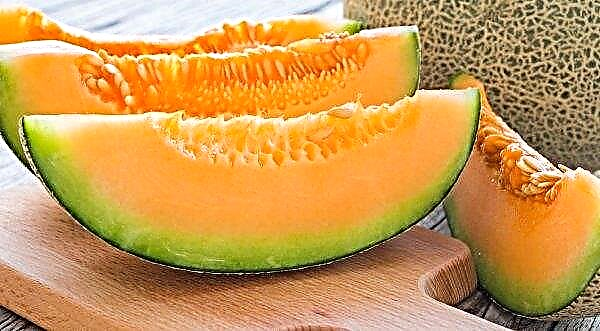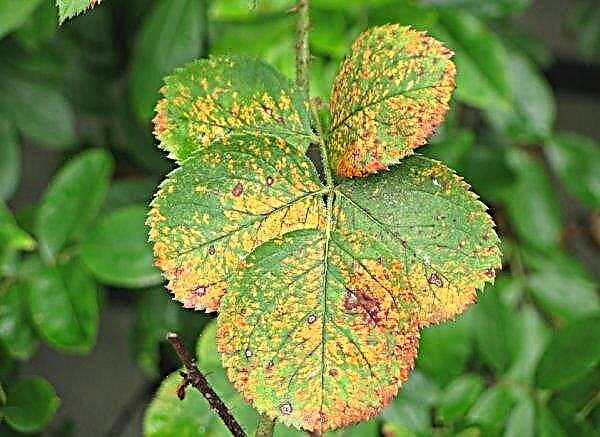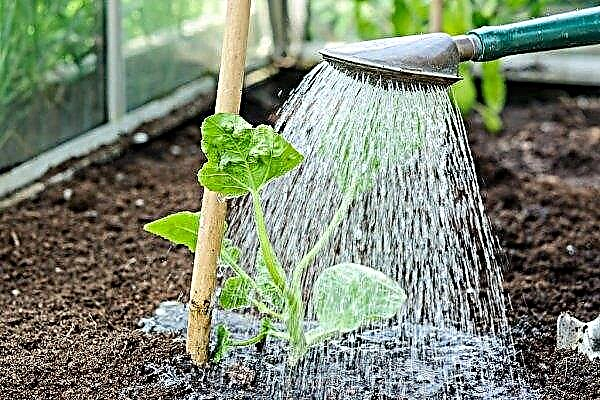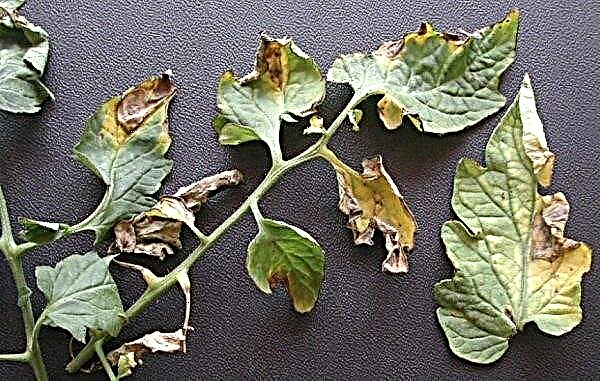Capsicum is an ancient vegetable plant that is used today in the cuisines of many peoples. Due to the content of a large number of valuable substances, it is also used in traditional and traditional medicine, cosmetology. Read more about the benefits, harms and uses of capsicum in this material.
Plant description
Capsicum, or vegetable pepper, is classified as Kapsikum and the Solanaceae family. This is a popular crop, which is often grown both on an industrial scale and in home gardens on all continents (in the tropics, subtropics and temperate climates). Its Latin name - Capsicum - the plant received due to the shape of the fetus and life expectancy: sápsa - “bag” + annuum - “annual”. The birthplace of culture is South America, where you can still find wild shrubs. The plant grows from 20 to 120 cm in height. He has simple leaves that grow singly or in a socket for several pieces. Their color can be green with various shades, even very dark. The plant blooms with large white or purple flowers. They are located on the bush individually or in bundles. After flowering, fruits are formed in the form of false berries with seeds. They can be different in shape, color and weight.
The plant grows from 20 to 120 cm in height. He has simple leaves that grow singly or in a socket for several pieces. Their color can be green with various shades, even very dark. The plant blooms with large white or purple flowers. They are located on the bush individually or in bundles. After flowering, fruits are formed in the form of false berries with seeds. They can be different in shape, color and weight.
This is a warm and photophilous vegetable plant that grows well in climatic conditions with temperature indices of +18 ... + 25 ° С on fertile soils. It can be grown in open ground, greenhouse, indoor environment. Planted it in seedlings. And only in the southern regions is it allowed to sow seeds directly into the ground.
Did you know? According to scientists, capsicum was first domesticated in the territory of Mexico and Guatemala by the ancient Mayans and Aztecs. Representatives of these tribes used hot vegetables instead of salt to add flavor to the food they consumed.
Pepper care is traditional: it involves watering, top dressing, loosening the soil, weeding, mulching, garter, pinching, preventive treatments against diseases and harmful insects. The yield of sweet varieties is on average 300 c / ha, of bitter ones - 200 c / ha. In sheltered soil you can get about 12 kg / m².
The best varieties of capsicum
All varieties of capsicum are divided into 2 varieties: sweet and bitter. Bitter varieties are also combined under the name of red (burning) pepper. Sweet is often called paprika. Bulgarian pepper is also included in this variety.
Among the best sweet varieties are the following:
- Gourmet. Fruits ripen in the early stages - 95-105 days pass from seedlings to harvesting. The plant forms peppers medium in size and weight (10–12 cm, 80–90 g). They are cuboid in shape. The skin is orange. Peppers are characterized by excellent taste and juiciness. In cooking, they are used for universal purposes.

- Fat Tooth. Fruits ripen in 105–110 days. They are elongated cuboid. The skin is yellow, glossy. The weight of one piece is 250-300 g. The pulp is tasty and juicy, with a pleasant fresh smell. The variety is valued for its high and stable yield - 3.6 kg / 1 m², excellent taste and large fruit size.
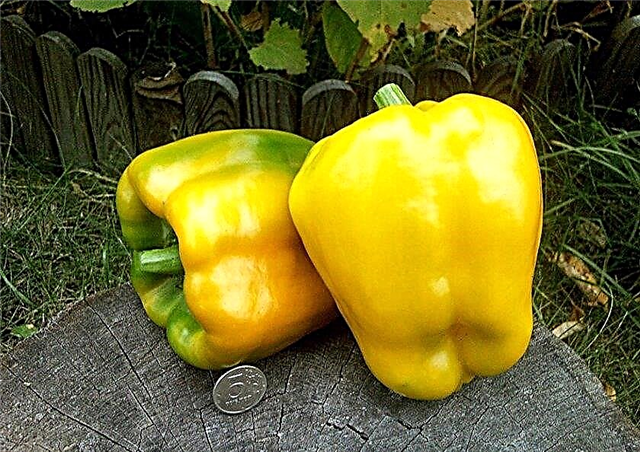
- Amber. Fruits ripen in 112–127 days. Peppers are tied in the shape of cones, weighing 90–110 g. Their skin is smooth, colored in orange. Productivity is high - up to 7 kg / 1 m².
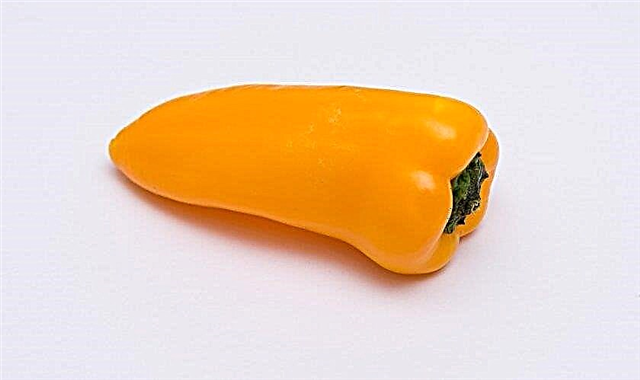
Popular among spicy varieties are:
- A burning bouquet. It produces fruits in the form of long pods up to 10 cm long and weighing 25 g. They have aromatic and sharp flesh.

- Chinese fire. Differs in excellent portability and keeping quality. Fruits ripen in 100 days. Pods reach a length of 21-23 cm, weight - 70 g.

- Anniversary VNIISOK. The growing season lasts 100 days. Pods grow 30 cm in length and gain up to 30 g of weight. They have a slight pungent taste and pleasant aroma.
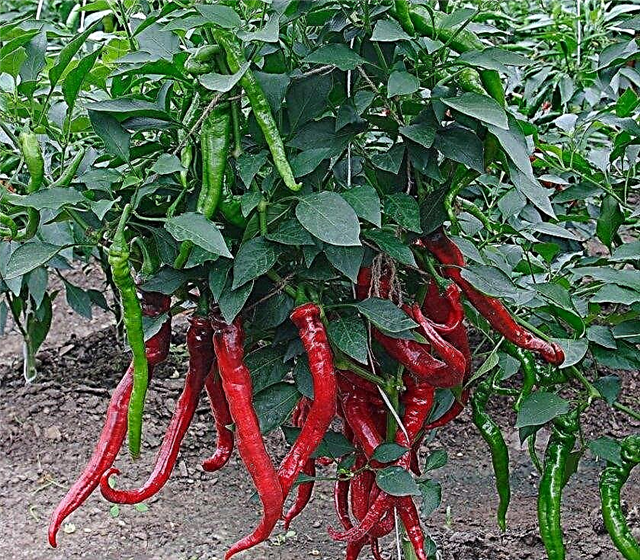
In room conditions, the following varieties are grown:
- Indian summer;

- Bell;

- Tomboy.

Composition and nutritional value
Capsicum is a real storehouse of valuable elements. Practically all known vitamins are contained in 100 g of vegetable. Vitamin C is especially high in it: in sweet varieties it contains 150 mg (166% of the daily norm for the human body), in the bitter ones - 143.7 mg (159.7%). Saturated vegetable and vitamins A, groups B, E, K, PP.
Of the minerals, a vegetable plant boasts a content of potassium, calcium, magnesium, sodium, phosphorus, iron, manganese, copper, selenium, zinc. The vegetable also contains the alkaloid capsaicin (in sweet varieties it is small, in acute varieties a large amount), sugars, essential and fatty oils, saponins. The energy value of 100 g of sweet vegetable is 27 kcal.
Did you know? Capsicum is included in the list of 10 most useful foods, which is compiled by specialists of the World Health Organization.
The nutritional value of the same amount of product is as follows:
- proteins - 1.3 g;
- fats - 0.1 g;
- carbohydrates - 5.3 g;
- organic acids - 0.1 g;
- dietary fiber - 1.9 g;
- water - 92 g;
- ash - 0.6 g.
Calorie hot pepper is 40 kcal. One pod contains approximately 18 kcal.
The nutritional value of 100 g of hot pepper is represented by such components:
- proteins - 1.87 g;
- fats - 0.44 g;
- carbohydrates - 7.31 g;
- dietary fiber - 1.5 g;
- water - 88.02 g;
- ash - 0.87 g.

Capsicum Properties
A vegetable can have both beneficial and harmful properties on the human body. There is a category of people who should use it with caution. It is generally contraindicated to some.
Benefit
- The rich chemical composition of a vegetable plant determines its benefits to the human body. It is appreciated and recommended to be necessarily introduced into the diet due to the fact that it has the following beneficial effects:
- improves the immune system;
- activates the secretion of gastric juice and increased appetite;
- adjusts the contractility of the digestive tract;
- balances the nervous system;
- Helps lower blood pressure
- accelerates metabolism;
- contributes to weight loss.

For men
Hot peppers are very useful for men, because one of its known properties is a beneficial effect on men's health.
- A vegetable is capable of:
- improve potency;
- increase testosterone levels;
- clear the liver;
- prevent early hair loss;
- increase blood circulation.
For women
Women are also advised to consume spicy varieties. They help to establish an emotional and hormonal background, the menstrual cycle, remove edema, reduce weight, and cheer up. With pregnancy and breastfeeding, acute varieties can not be eaten.
Important! In the diet of a nursing woman, sweet pepper may appear after the baby is 3 months old. A woman should enter it gradually, starting with small doses, carefully monitoring the condition of the baby.
Lactating women should also not eat orange and red fruits. But sweet pepper is recommended for use by pregnant women. It saturates the woman’s body weakened at this time with elements important to her and the fetus, in particular, calcium, iron, folates.
For children
Sharp varieties for children are contraindicated. They can lead to serious irritation and burns of the delicate mucous membranes of the mouth and digestive organs. For the first time, a burning vegetable can be tasted only after reaching the age of 12.
Sweet varieties are allowed to be given after heat treatment from 9 months. Fresh vegetables can be entered on the menu, starting from 1.5 years. It will saturate the child’s body with a vitamin-mineral complex, as well as energy, help to improve appetite, improve the motility of the stomach and intestines.
Harm and contraindications
Sweet varieties are undesirable for people with liver and kidney diseases, coronary heart disease, hypotension, epilepsy, gastric ulcer, gastritis, and individual intolerance.
Hot pepper is contraindicated for people with impaired renal and hepatic function, with diagnoses of “ulcers”, “diabetes mellitus”, “hypotension”, as well as for pregnant and lactating women, during menstruation, and children. The maximum allowable amount of burning vegetables that can be consumed per day is 15 g. In order not to harm the body, it is optimal to eat it 1-2 times a week.
Application
Capsicum has found application in many areas - in cooking, nutrition, cosmetology, traditional and traditional medicine.
Important! Reduce the severity of hot pepper by removing the seeds of the inner plates, as well as heat treatment.
In cooking
Capsicum is actively used by peoples around the world.
Spicy vegetable is added to:
- seasonings and sauces for meat and fish dishes;
- side dishes made of vegetables;
- first dishes, cereals and legumes;
- salad dressings;
- vinegar, marinades, vegetable oil.

Sweet varieties are used to make:
- salads;
- stuffed dishes;
- soups and borsch;
- lecho.
Important! When preparing dishes and hot pepper products, care should be taken to protect the hands with gloves. Hands after contact with a burning vegetable should not touch the face and eyes. This causes severe irritation.
In folk medicine
Today, more is known about the use of burning vegetables in medicine. Moreover, it is used not only in folk healing, but also in official medicine.
It is among the ingredients:
- medical patch prescribed during muscle and joint pain, arthritis, rheumatism;
- tinctures to enhance appetite and better digestive function;
- anti-malaria and frostbite agents;
- "Tonsipret" from diseases of the upper respiratory tract.

In folk medicine, pepper tinctures, infusions and decoctions are used to treat arthritis, genital herpes, enterocolitis, gout, radiculitis, dysentery, colds, coughs, osteochondrosis:
- The infusion is made from ground pods (10 pcs.), Unrefined vegetable oil (250 ml), purified kerosene (250 ml). They stand it for a week. Apply externally.
- For tincture take alcohol (70%), ground pods in a ratio of 1: 3 and can withstand 3 weeks.
- The broth is boiled from a crushed pod (1 pc.) And milk (1 tbsp.) For 2 minutes.
- A cough remedy from crushed red vegetable (1 pc.) And honey (1 tbsp.) Helps to cope well.
Sweet peppers are also used to get rid of some health problems. Its juice helps relieve inflammation in stomatitis and gingivitis, solve the problem of unstable thyroid function and iodine deficiency. In case of violations in the activity of the pancreas, raising the level of glucose in the blood, it is advised to drink 30-150 ml of juice three times a day before meals. In the treatment of arthritis and rheumatism, lotions of pepper tincture in alcohol or vodka are used.
Did you know? Guinness Book of Records specialists in 2013 introduced pepper called Caroline reaper onto its pages as the sharpest kind of chili. In 2016, a resident of Jamaica Wayne Algenio ate 22 pods in 1 minute.
In cosmetology
Sweet pepper juice can be used externally to lubricate age spots. If mixed with carrot juice, this will be an excellent tool in order to make imperfections on the face invisible. Pepper and carrot juice is also used to get rid of eczema and dermatitis. Sharp vegetable tincture is used to eliminate cellulite. They rub it into problem areas or add it to an anti-cellulite cream. Red vegetable also solves the problem of stratification of the nail plate. A mixture of hand cream (1 tsp), chopped pepper (0.5 tsp), water (15 drops), citric acid (at the end of a knife) is kept in a water bath for 15 minutes with constant stirring. After cooling, lubricate her nails, wrapping them with a film for 20 minutes.
Red vegetable also solves the problem of stratification of the nail plate. A mixture of hand cream (1 tsp), chopped pepper (0.5 tsp), water (15 drops), citric acid (at the end of a knife) is kept in a water bath for 15 minutes with constant stirring. After cooling, lubricate her nails, wrapping them with a film for 20 minutes.
When losing weight
Both sweet and bitter varieties are effective in reducing weight. The former contain few calories and a lot of fiber. They contribute to the burning of calories, cleansing the body of toxins, speeding up the metabolism, the establishment of the digestive tract. They are well digested by the digestive system. But best of all, a burning vegetable solves the problem of excess weight.
On its basis, several diets have been developed. The most famous of them is Mexican. And the most popular diet dish is tomato soup with chili peppers. Traditional healers have developed a tincture that allows you to get rid of extra pounds. It is prepared from finely chopped vegetable and alcohol or vodka, it is insisted for 5–20 days, and then they drink 30 ml a week for half an hour before meals. Wraps with a mixture of olive oil (3 tsp), coffee (1 tsp), sea salt (1 tsp), ground pepper (0.5 tsp) also allow weight loss. The product is applied to the skin, wrapped with a film and held for 30 minutes. The course is 8-10 sessions. They are carried out every other day.
Wraps with a mixture of olive oil (3 tsp), coffee (1 tsp), sea salt (1 tsp), ground pepper (0.5 tsp) also allow weight loss. The product is applied to the skin, wrapped with a film and held for 30 minutes. The course is 8-10 sessions. They are carried out every other day.
To strengthen hair
To strengthen the hair, use hot pepper. Rub the tincture into the scalp to positively affect the hair follicles.
Masks from the following components are also used:
- Pepper tincture (1 tbsp. L.), Castor oil (2 tbsp. L.), Shampoo (2 tbsp. Mask is applied under the film for 60–90 minutes.
- Cognac (100 ml) and ground pepper (10 g) insist in a dark place for a week. Before use, add boiled water in a ratio of 1:10. Rub into the scalp before bedtime without rinsing. The course is 1-2 months.
Thus, both sweet and bitter varieties of capsicum with regular but moderate use bring great benefits to the human body. However, before you enter them into your diet, you should make sure that you are not on the list of persons to whom the vegetable is contraindicated.










